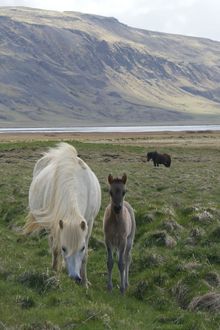Developed from ponies taken to Iceland by Scandinavian settlers in the 9th and 10th centuries, icelandic horses are mentioned in literature and historical records throughout Icelandic history; the first reference to a named horse appears in the 12th century.

An Icelandic mare and foal
Filmmakers are creating a documentary revealing the rich cultural and environmental history of the Icelandic horse and the people who have created this unusual and wonderful way of life for the horses.
© 2012 by Aubrey
Horses were venerated in Norse mythology, a custom brought to Iceland by the country's earliest settlers. Selective breeding over the centuries has developed the breed into its current form. Natural selection has also played a role, as the harsh Icelandic climate eliminated many horses through cold and starvation. In the 1780s, much of the breed was wiped out in the aftermath of a volcanic eruption.
Although the horses are small, at times pony-sized, most registries for the Icelandic refer to it as a horse. Icelandic horses are long-lived and hardy. In their native country they have few diseases; Icelandic law prevents horses from being imported into the country and exported animals are not allowed to return.
The Icelandic displays two gaits in addition to the typical walk, trot, and canter/gallop commonly displayed by other breeds. The only breed of horse in Iceland, they are also popular internationally, and sizable populations exist in Europe and North America. The breed is still used for traditional farm work in its native country, as well as for leisure, showing, and racing.
The first breed society for the Icelandic horse was created in Iceland in 1904, and today the breed is represented by organizations in 19 different nations, organized under a parent association, the International Federation of Icelandic Horse Associations.
Now, filmmakers Lindsay Blatt and Paul Taggart are creating a documentary that reveals the rich cultural and environmental history of this breed and the people who have created this unusual and wonderful way of life for the horses.
Blatt and Taggart write, “During the summer months, the horses live a wild existence, grazing in the highlands and raising their young. Each fall, they are rounded up by local farmers and directed across the stunning landscape. This valued tradition is a social and cultural touchstone for both the farmers who own the horses and the city dwellers who travel to the countryside to participate."
"The horse holds a precious place in Icelandic culture, art and tradition; for over 1,000 years Icelandic law has prohibited the importation of horses onto the island. By telling the story of this annual journey, Herd in Iceland captures the symbolism behind the horses and the nation they represent.”
